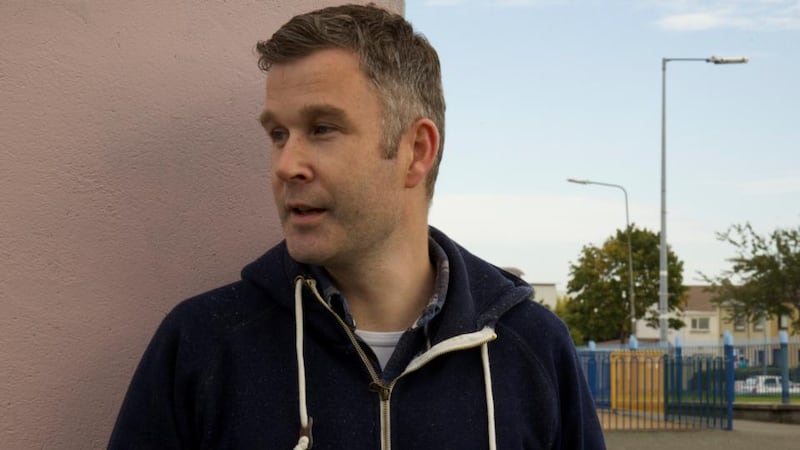It involves little hyperbole to argue that Frank Berry is now among our most significant film-makers. Ballymun Lullaby, his documentary on music teacher Ron Cooney, won many friends in 2011. The director's first dramatic feature, I Used to Live Here, a winner at last year's Galway Film Fleadh, seems likely to spread the word still further.
No pampered film-school kid, Berry has had to work hard to get those two features on screen. He learned his trade making community and charity videos.
I Used to Live Here looks, in some ways, like an extension of his community work. Berry, working with the citizens of Killinarden in Tallaght, set out to make a film dealing with the grim phenomenon of suicide clusters.

"It all started with articles in The Irish Times by Tony Bates that talked about how, when a suicide occurs in a community, it can affect other people in the community. That had a lasting impact on me." Dr Bates, founding director of Headstrong, the National Centre for Youth Mental Health, explained how, when somebody killed themselves in a close community, the tragedy could open up suicide as an option to those who had not previously considered it.
“That’s right. A suicide cluster is a rise of suicides in a particular place at a particular time,” Berry says. “You are statistically more likely to experience a suicidal thought if you’ve been exposed to a suicide. A lot of young people are at an age where they’re not able to comprehend the finality of the act. They don’t really understand what they’re talking about.”
Berry originally intended to make a documentary in the style of Ballymun Lullaby but he was uneasy about putting a real case before audiences. He came up with a story and was eventually manoeuvred towards a group in Killinarden who had made a DVD on the same subject.
“I had a meeting with them and that was pivotal,” he said. “They told me a lot about the lives of young people in their area and I realised we had a shared conviction.”
Working with local non-professional actors, Berry has produced a film that, although developed organically over many months, ends up looking unexpectedly elegant. The terrific Jordanne Jones plays a girl who, having recently lost her mother, is pressed down further by a suicide in the community. Young Dafhyd Flynn is equally strong as a kid kicked left and right by bullies and frustrated by a dad who can’t quite connect.
"Everybody round the community centre could engage with the film or not engage with it," Berry says. "Anybody who walked in could get involved either in front of or behind the camera. We didn't use the word 'acting' or 'audition', as that might imply an X Factor scenario. Some would come through the doors and then come back. Others would never dream of acting. It just happened organically."
Remarkable presence
I Used to Live Here has a loose structure that allows tension to steadily accumulate as we drift from one everyday crisis to the next. Although the film is inspired by the suicide-cluster phenomenon, the research is buried deep in the mix. Memories of the recently departed neighbour serve as sombre background music to the varied tensions of city life.
Jordanne Jones’s remarkable presence helps hold the piece together. How did she stand out from the crowd? “There’s a quality about her,” Berry says. “She was quiet but also very, very smart, and that’s always an interesting combination. And she’s also very funny. As soon as I saw her on camera, I could tell she was a great choice. She is always asking questions. You are not just telling somebody what to do.”
Inevitably, some of the actors brought their own experiences to the development of I Used to Live Here. But Berry is keen to stress that the project is very definitely a work of fiction. No recent case has been "torn from the headlines".
“I didn’t give them traditional direction,” he says. “James [Kelly], who plays the father, works in Community Addiction Response and has strong opinions. We talked a lot about men and men’s mental health in the area. So conversations over long periods of time became very beneficial. The discussions about what the film was about were inclusive.”
Excellent wide-screen cinematography by Colm Mullen and a sleek minimalist score add to the ambience of a film that doesn’t look much like the work of any other director. I mention Ken Loach, Robert Guédiguian and the work of the Iranian neo-realists, and Berry nods.
“They were definitely in my head, without doubt,” he says. “I particularly like [American director] Ramin Bahrani and I was talking to Colm, the cinematographer, about [Romanian] Cristian Mungiu. In his last two films, almost every scene was done in one shot. That is an approach I wanted to bring. I didn’t want to make it like a movie.”
I know what he means. But I Used to Live Here really does look like a movie. It doesn't seem like a workshop or an experiment. It feels complete and contained. The world is sure to take notice.
I Used to Live Here is on limited release
MOONLIGHTING: NON-PROFESSIONAL ACTORS ON SCREEN
Directors don't like to use the word "amateur" about actors who don't normally do the job for a living. You can see why. The Italian neo-realists couldn't have thrived without those ordinary faces: Enzo Staiola as the disappointed boy in Bicycle Thieves, Carlo Battisti as the evicted old man in Umberto D, and Enrique Irazoqui as Jesus in The Gospel According to Matthew.
Ken Loach followed their example by casting David Bradley as the disadvantaged hero of Kes.
The Iranian new wave of the 1990s was built on work featuring non-professional children. Just two years ago, five-year-old Quvenzhané Wallis received an Oscar nomination for Beasts of the Southern Wild. Don't tell the unions.



















